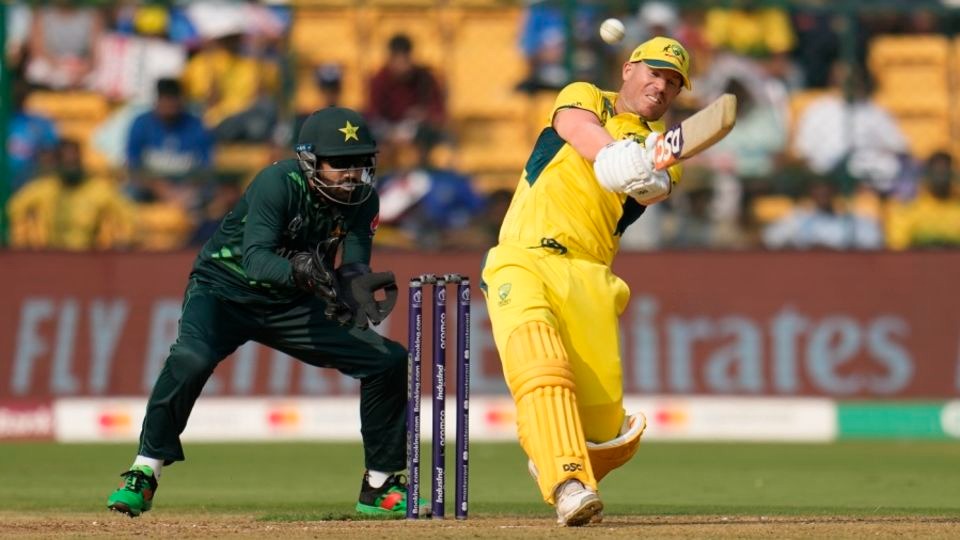Warner still the GOAT-to option for Australia at World Cups

Last year, Virat Kohli hit a six off Haris Rauf that everyone raves about all the time. On Friday afternoon at the Chinnaswamy Stadium, David Warner hit Rauf for a six that was just as astonishing. Take away the context of Kohli's six, and maybe, just maybe…
But why compare at all?
Here's how the Warner six unfolded - and that word is chosen with some deliberation, because the shot was a miracle of folding and unfolding. Rauf, angling the ball in from round the wicket, went full and at the stumps at 146.1kph. It was the kind of ball that's difficult to get underneath and hit in the air in any direction. Warner didn't just hit it in the air, but made it clang into the roof of the stand at backward square leg.
He did this by falling backwards and across his crease, folding his back knee so his leg collapsed under him, and unfolding his front knee so his stiff front leg, landing lightly on his heel, now pointed somewhere between square leg and midwicket. All this happened in a split second, of course, enabling him to create room for a scoop that harnessed the ball's pace and angle to the fullest possible degree.
"It's just pure instinct," Warner later said of this shot. "I knew I'd faced him before plenty of times and I think the line and length and the pace that he bowls, it's just one of those shots that, at a ground like this, it's a small boundary. So, you know, if you get anything on it and it's in your arc, you can just go with it. That's how I've always intended to go out and about it. And yeah, he bowled it pretty much in my arc where I wanted him to bowl."
There was another moment of knee-folding innovation later in Warner's innings, when he was in the 90s. This came off Mohammad Nawaz, a left-arm spinner, and therefore
By this point, Warner was batting on 97 off 79 balls. At the other end, Mitchell Marsh was on 87 off 92. Warner was rattling along at a significantly faster clip despite having scored fewer runs in boundaries (60) than Marsh (66).
As much as Warner's ability to manufacture boundaries out of nothing, this innings also showcased his ability to score runs via actual running. It's an ability matched by very few in world cricket - he once made, for instance, a Test century at the Gabba that contained as many twos and threes (14 in all) as boundaries. This is partly a product of his speed and endurance, of course, but the less-spoken-about aspect is how well he uses his hands to manipulate his bat face and place the ball in gaps.
These hands set Warner apart from a batter like Marsh, who can make your pulse race with the power and authority of his boundaries - a front-foot square cut off Hasan Ali early in his innings set off an audible gasp in the press box - but who also hits the ball straight to single-saving fielders fairly often.
This is no criticism of Marsh, who played a superlative innings on Friday and is among the most dangerous top-order batters in ODIs today. Plenty of top-drawer players bat like Marsh does. Warner, though, sits at a level only occupied by a handful of others. He can destroy bad bowling, he can put good balls away for boundaries, and it's extremely rare for any bowler to tie him down by dotting him up.
It's why he's one of only three batters to score more than 5000 ODI runs at a 45-plus average and a 95-plus strike rate. AB de Villiers and Quinton de Kock are the other two.
Those ODI numbers put Warner in all-time-great territory, and while it's broadly agreed that he is, indeed, an all-time-great ODI player, his name doesn't slip into conversations about ODI GOAT-ness in the way some others routinely do.
There are many possible reasons for this. Aesthetics isn't one of the major ones, but it certainly plays a part. Warner isn't by any means unattractive to watch, but his game has a pared-down, functional quality to it. Soon after he'd brought up his hundred, for instance, he stroked Rauf for an extra-cover drive that was as effortless as anything Babar Azam might play. But where Babar almost always holds his pose at the finish of his drives, Warner lets his innate busyness take over; on this occasion, he began skittering down the pitch almost as soon as he'd made contact with the ball, even though there was no need for anyone to run.
Mostly, though, Warner's absence from the GOAT conversation is down to how little 50-overs cricket he's played. Friday's game at the Chinnaswamy was only the 154th ODI of a career that began 14 years ago. Since his debut, in fact, 14 batters have scored more runs than he has.
Warner, though, has always scored runs when the world has trained its eyes on him. He's presently the seventh-highest run-getter in World Cups, and isn't far behind either Virat Kohli in fourth or Rohit Sharma in fifth. Only Rohit and Sachin Tendulkar have more hundreds, and of the 22 batters with at least 1000 World Cup runs, Warner has the fourth-best average and the third-best strike rate.
These are, once again, the numbers of an all-time great. In just about a month's time, when he's done with this World Cup and in all likelihood his ODI career too, it's likely they'll look even more imposing.
